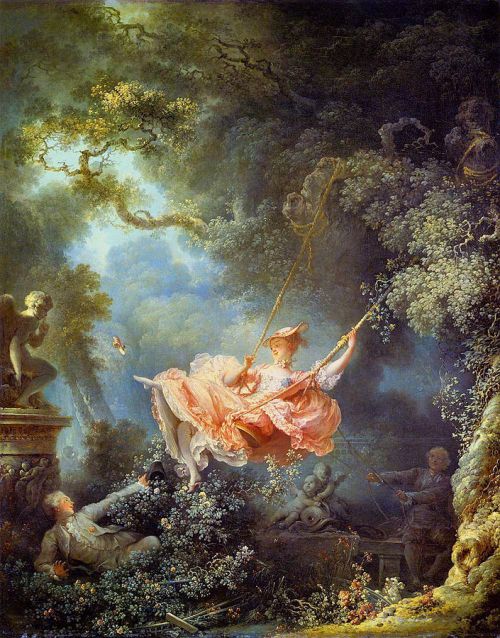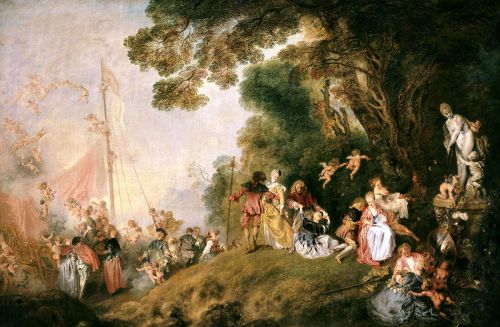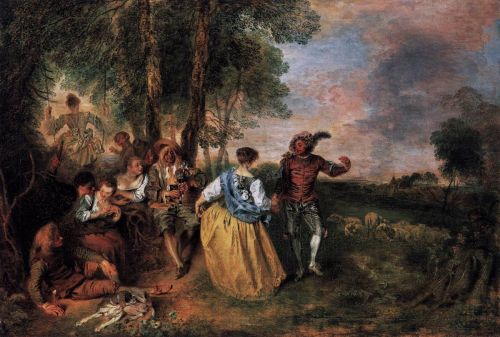(This is an abridged fragment of Maria Rzepinska Siedem wiekow malarstwa europejskiego. The translation is mine).

Jean-Honore Fragonard The Swing 1767
In the eighteenth century, freethought and fashion for atheism in society led to the secularisation of painting. This does not mean that religious art disappeared altogether. Churches and monasteries were still built and there was still a need for religious paintings and decorative art. But what is the most original and most creative in painting of the eighteenth century is of worldly nature. The spirit of sacred solemnity vanishes from religious paintings. Artists lose interest in ancient myths which had been the subject of art for centuries.
Jean Marc Nattier The Lovers 1744
Mythology became merely an aesthetic pretext. In comparison with the seventeenth century, the Rococo style of painting is less serious. It is also less inventive in terms of technique. Rococo is the last historical style, compact and uniform, covering all artistic disciplines, costume, life-style, and the arrangement of urban space. It did not last long and new trends emerged around 1760, stemming from a different aesthetic attitude, as well as from new social and moral tendencies. Some historians consider Rococo to be the last phase of Baroque but the former is different from the latter in many aspects, including asymmetry and caprice as aesthetic principles and a radical change in the treatment of colour. Historians argue whether Rococo emerged in in France or Italy, with Borromini often being considered as the precursor of this new style. However, there is no doubt that interior decoration and Rococo painting are an expression of French culture, strictly speaking the culture of French aristocratic salons. Rococo is closely associated with the leisure class – a social class with a sophisticated and refined taste. There is neither populism nor naivety in Rococo, whereas they often can be found in Baroque.

Antoine Watteau Pilgrimage to Cythera , 1718–1721
Rococo is the style of a social class at the top of its power. Women played a particularly important role in the society of the eighteenth century. Painting, furniture and interior design are all feminine. Rococo is the style of grace rather than strength and dignified gravity. It is significant that this epoch gave us more female than male portraits.

Francois Boucher Diana Leaving the Bath 1742
The time of artistic hegemony of Italy had passed. France dictated how people dressed and what they thought in Europe. It is France that gave the world Watteau, Boucher, Chardin and Fragonard. The French language became the common language among educated classes. France is the home of Rococo, and there the feminine character of this style was particularly strong. In painting, colours became brighter while darker shades disappeared. Tenebrism was rejected as unbecoming and old-fashioned; graceful demeanour, dance, flirt, carnival – everything that served hedonism – came to the forefront. Portraits of members of the court and the great allegorical paintings with courtly themes were still painted, but they were considered anachronistic.

Jean-Honore Fragonard The Stolen Kiss, late 1780s
The quarrel of Poussinists and Rubenists ended with the victory of the latter. French painters opted for continuing the tradition of the sensual, lush and colourful Flemish painting, re-interpreting it in an original way. What is most interesting in the painting of this time is the emphasis on the life of the rich and elegant groups of the French society who were shown as being more interested in charms and pleasures of existence than in wealth and social position. Changes in architecture influenced to a certain extent the style of painting which became more private, graceful, intimate, and devoid of rigid ceremonialism and pomposity. Small cozy interiors, charming salons and boudoirs dictated a particular range of themes, figures, and formats. In addition to oil painting, pastel drawing was also very popular. Artists used a range of pastels that were bright and chalky, with artwork often resembling oil painting. Baroque’s limited palette of chromatic pigments and a wide range of colours was replaced in Rococo by light, bright and cool colours, with a lot of white, pearly and pigeon shades, and a wide range of tones of blue, from azure to pervenche.

Jean François de Troy Declaration of Love 1731
New colours were used, including violet, peach and willow-green – sometimes bleachy and greyish, sometimes clean and cheerful, but almost always bright. A new form of painting emerged, namely paintings painted on canvas and fixed on the wall, shaped to fit the architectural space, often capricious and irregular, placed as overdoors or between the windows or mirrors.

Nicolas Lancret La Camargo Dancing, c. 1730
Painters often used the oval form for portraiture, which was not used before. The artists, even of the prominence of Boucher, were not averse to painting fans, crating designs for screens, furniture or upholstery. In the sixteenth century, painters show little interest in architecture or sculpture, preferring decorative and applied arts. The fashion for the Chinese art and culture, which was triggered by the interest in porcelain and lacquerware, found its fullest expression in applied art although it could also be found in some easel paintings. In Boucher’s paintings, for example, we can find Chinese motives such as local characters, clothes and pagodas, although they are often far from being realistic.

Francois Boucher Chinese Garden (detail) 1742
Theatre was particularly popular. All social groups enjoyed all kinds of performances including comic opera, ballet, farce, pantomime and vaudeville. In Paris, alongside the French comedy, the Italian comedy was also highly popular. The latter, banished during the reign of Louis XIV, reappeared in France in 1716, during the period of Regence. The Italian commedia dell’arte served as a source of inspiration for some of the most interesting French paintings of the time. The return of the Italian actors to Paris rekindled the interest in the mystery and the beauty of masks and costumes, and the characters of the Harlequin, Mezzetino, Il Dottore and Colombina. Important motifs were the traditional “four masks of Italian comedy” (described by Goldoni in his memoirs), as well as from the Venetian carnival.

Nicolas Lancret Actors of the Comedie-Italienne
The themes from the theatre and ballet often appear in the paintings of Gillot, Watteau and Lancret. These painters not only paint objects from theatrical performances in their physical form but they also treat masks, lipstick, wigs and various forms of disguise to convey meaningful subtexts which are not always cheerful. These objects changed the formula for painting the human figure which became dissociated from the ancient model.

Antoine Watteau Pierrot, 1718–1719
The landscape in Rococo paintings is theatrical, imaginary and tapestry-like rather than realistic. Nature in Rococo is pastoral and idyllic, and never harsh, menacing or mysterious. The emphasis is on what is carefree, erotic and playful in Nature, poetry and theatre. People were preoccupied with the quest for happiness. Hedonism and eroticism were among the dominant motifs of the eighteenth-century culture. The new sensitivity of artists was displayed in its clearest form in the paintings of Watteau who is a Rococo painter par excellence.

Antoine Watteau The Shepherds c.1717
